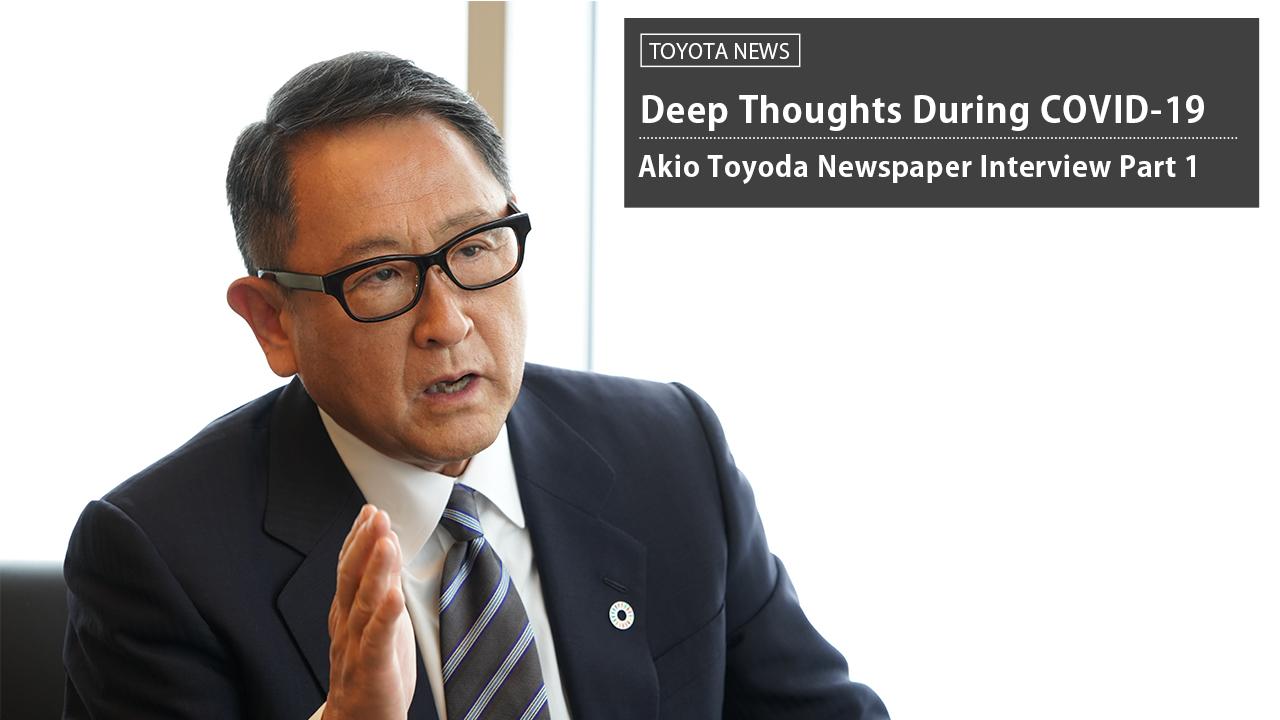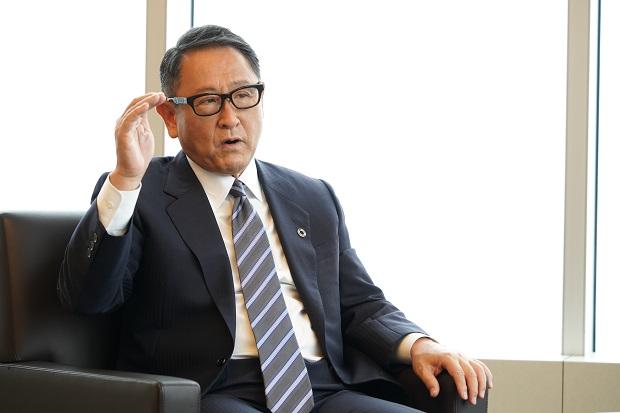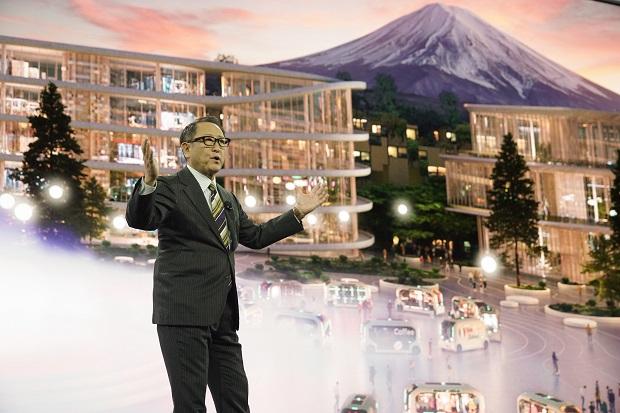
President Akio Toyoda was recently interviewed by the Chunichi Shimbun, resulting in an article that was published in the morning edition of the newspaper on July 7. Toyota Times will be bringing you additional content (and fresh content in English!) from behind-the-scenes over a two-part series.

On July 7, an article featuring an exclusive interview with President Akio Toyoda was published in the morning edition of the Chunichi Shimbun, a local newspaper in Aichi Prefecture where Toyota Motor Corporation has its headquarters. In the interview from which the article was based, Akio shared his thoughts on a wide range of topics, including changes in work and life brought by the spread of COVID-19; Akio’s thoughts on the new executive structure announced on June 30; and his image of his successor, or the type of person he would like to pass the baton to as the next president of Toyota.
To help everyone have a chance to hear the thoughts shared by Akio in the interview across a variety of topics, Toyota Times will share excerpts from the minutes of the interview via a two-part series.
Part one: Deep Thoughts During COVID-19 Crisis
Part two: Leadership & Succession
To start off, the first part of the two article series carries the overall theme of: “Thoughts during the COVID-19 pandemic.” Here Akio shares his thoughts on changes Toyota has made from past crises, serving as a reassurance of the direction the company management is going, as well as what he has experienced from his own days of “staying-at-home” at one of the company’s corporate executive training facilities. The format of this article will follow the pattern of the interview format, with a question being asked and then Akio responding.
Akio says “thank you” to team members
Q. Through the support measures you have taken in response to COVID-19, you said you observed changes in actions taken by Toyota’s team members. What changes did you see?
Akio
We have encouraged our own team members to support those who produce medical equipment with Toyota’s know-how. Funahashi is one the companies we have supported, a company that produces medical protective gowns. With the additional help, they managed to produce about 5,000 units a day, up from the previous level of 500.
People at Funahashi shared with me that the efforts have helped garner an appreciation from a lot of medical workers for these types of support activities, which made the Funahashi team happy. I’m glad that we can be of help in this way, especially leading to where people can thank each other and where it helps to put smiles on their faces.
After the Great East Japan Earthquake in 2011, internally, I repeatedly reiterated the order of priorities to be, “Safety first, regional reconstruction second, and then the restoration of production.” That feels like such a long time ago. People at the genba can now think and act for themselves without any reminders. This is how we have changed over the last decade or so.
But actually that’s how Toyota was to begin with. In line with genchi genbutsu (going to the source to get the facts), I believe that the people closest to the things, customers and the market, should have the biggest say and we should respect their opinion the most. Toyota was a company with support staff thinking about how to help those people in genba. However, unfortunately, sometimes I feel as though we have started to listen more to people in planning sections and people with titles attached to their names [than those in the genba].
I want the people in top management positions to see their “title” as a “role.” Both the people assigned to handle specific projects and those in top management positions have “roles.” However, the people in the top management positions have “titles” in addition to their “roles.” The question is how are they utilizing their “titles?”
At first, I’m sure people became lost and wondered about me, trying to figure out what I as the president wanted to prioritize. However, more people understand what’s on my mind now.
I observe the genba (where work takes place) carefully. I try to listen to the people who know the facts the most. It’s a little more reassuring now because more supervisors act the same way.
Looking back at the past 11 years since I became president, I can’t recall a single year of peace and quiet. This is just another eventful year with the COVID-19.
However, the biggest difference between the past and the present is that I’m calmer now. We still don’t know what the future holds and we don’t have any answers, but I believe I’m calmer now because I have more allies who are thinking about what to do together.
Normally, I might sound like I'm always “complaining” to team members. That’s precisely why I want to show my gratitude to everyone whenever I can (like I did at the Shareholders' Meeting).
I say harsh things because I am the one being held responsible for the actions of the company. When I look back on my own life, I was treated the same way and I am grateful for that because it helped me realize things I wouldn't have if I had been on my own. I think I'm in that position now, so I think it's my role to say such things.
But I want to let everyone know that I do have a relationship with our team members where I can say "Thanks" and express my gratitude.

Akio officially became the president of Toyota in June 2009. Just two months prior to taking on that new role, he delivered the below message to employees. As you read the message, please note his explanation of how he sees the importance of “genba” and “genchi genbutsu,” two guiding principles which remain unchanged, even today.
- Akio remarks in April 2009
-
Genchi genbutsu is not just about going to the actual site and having a tour. It is actually about the idea of understanding things happening in front of you with ownership and of making efforts to improve where possible. With continuous improvements steadily conducted, your work becomes easier, more enjoyable, and can make others around you happy too.
Sakichi and Kiichiro Toyoda both firmly had this genchi genbutsu principle whenever they tried to do things. Kiichiro actually once wrote the following memo about an ideal attitude of an engineer:
“Japanese engineers are mostly working behind the desk, and this makes them less confident when executing their work in a real life. They don’t have enough power to push things forward with the fear of getting criticized by others. With these types of engineers, we cannot make vehicles.”
He later would use the phrase that “engineers who don’t wash their hands three times a day are no good.” (This implied that they should get their hands dirty and take an active role in whatever they are making.) As we can tell from these messages, I believe there was a corporate culture of “respecting those who know genba the most.”
Based on this line of reasoning, it can be said that titles do not matter. In the end, it is those who actually see what’s happening at the genba that matter. Those closest to things or the genba are to be respected the most. I have believed in the idea that “people can learn and grow with an attitude of genchi genbutsu”, and will continue to believe in this moving forward.
What stay-at-home life helped the president realize
Q. Since the declaration of a state of emergency following a surge in COVID-19 cases in Japan, you have been leading a sort-of hermit’s life at a company executive training facility in Aichi Prefecture, haven’t you?
Akio
I’m slowly returning to my normal life, but this “evacuation” made me realize a lot of things. My commute time has decreased and I don’t have in-person meetings as often now. Despite that, business goes on as usual. There were people I only saw maybe once a year, but I see them online more often now. Being unable to see each other usually causes a feeling of separation, but I feel as if we’ve gotten closer, emotionally.
I used to ask, “Please consult me” or “Why do you only come to me for an approval or only ask for permission?” but now I feel that people come to me for consultation more.
At the training facility, there are people here who cook and clean. I was feeling sorry for them. They were not able to have any of their usual days off because I was there, so I told them that, at the very least, they should spend time with their families during the Golden Week holidays. It was not like I was cooking rice over a campfire on my own, but I kept staff around me to a minimum and on a rotating basis while I spent time there. It was like lodging together.
Nobody notices me even though I walk around the supermarket with a mask. There were things I became aware of when I talked with the boss of a butcher there and, thanks to genchi genbutsu, I realized the difference in supermarkets that enjoyed a great reputation among the locals. I took as many people as possible to a hamburger shop, ordered a set menu, and in two out of the seven set menu toys, we got the miniature Supras!
Also, I did some coloring. There are colored pencils that you can do watercolor painting with when dipped into water. The crayons and colored pencils that I used as a child were quite different from these new ones. My hobbies have always had something to do with movement, such as driving cars or going out somewhere. I don’t have any “quiet” hobbies, where I don’t move at all, so I thought I’d try something I can do right away, like coloring or calligraphy.
I was able to concentrate. I can be very “Zen” when I drive, and when I am sharply focused on something. That is how I relax my brain. Certainly, during quarantine, physically straining myself was a lot easier to avoid as we didn’t need to move or go anywhere, so instead, I was mostly kicking my brain into full gear. I kind of wished I had some big or small ways to relax my brain.
Remembering to be “centered on people”
Q. Have there been any changes in your sense of values after facing the COVID-19 crisis?
Akio
What I’ve come to realize more is that the focus should be centered on people. Even if new technology or skills are developed, it all comes down to whether we can mass produce happiness to the people who are using it.
It’s not good if people say “Life has gotten easier, but the quality of life has come down.” Even with new ventures such as Woven City, having people at the center is most important and it is our role as those who have always been in the automotive industry to do so.
We have wrestled with environmental issues all along, but I think our main priority had been conforming to the regulations of each country and region. When SDGs (Sustainable Development Goals) came into the picture, I hoped mobility would be something that will be pursued by everyone forever, and my desire to provide the freedom of mobility to everyone strengthened all the more [based on the idea of “not leaving a single person behind” in the SDGs].
Another thing I thought of, regarding the SDGs, is that everyone is living on the same planet. We have been promoting “minus emissions” instead of “zero emissions,” and my desire to make Toyota a company that will be acknowledged as a company that focuses not only on certain regions, but the entire earth as its “home planet” was enhanced.
To provide some further background on this topic, it is prudent to refer back to when Akio shared his thoughts on SDGs at the financial results announcement briefing in May.
- Akio's remarks at the financial results announcement in May 2020
-
This crisis made me think about something. It made me think about how we, as human beings and as companies, should live our lives. With Earth, with society, with all stakeholders—live together.
Just as in the case of a hometown or home country, that means taking care of a “home planet” in the course of conducting corporate activities.
And there is another thing—one that many people have been reminded of. It is the feeling of appreciation for, of course, all the people on the front lines of the medical sector protecting our lives, but also for all the people who are supporting our everyday routines.
When what we take for granted ceases to be a matter of course, we notice that nothing is a matter of course and that we have things thanks to someone somewhere working hard.
We want to create a relationship in which people can say thank you to each other and can thank the Earth. Companies and people need to think seriously about how to live, and then change what they are doing. It could be that we have all been given a great chance. And that chance might be the last one.
I believe that our mission is to provide goods and services that make people throughout the world happy, or, in other words, to “mass produce” happiness.
To achieve that, I believe that it is necessary to cultivate Toyota people in the world who can wish for and take action for the happiness of those other than themselves. That means developing human resources that have what I like to call a “you perspective”.
To this is what I will devote my own heart and soul, for the “COVID-19 era” and “post-COVID-19 era.”
And I view this as also being a part of earnestly engaging in the sustainable development goals, or SDGs, for which international society is aiming, with the stance of “no one will be left behind.”
Leading projects using a “venture mindset”

Q. Since the launch of the Woven City Project in January this year, what is the status of the project?
Akio
There are regular meetings among those involved in the Woven City Project. To help me follow the various tasks, the schedule is organized by putting them into groups, such as "Things We Want to Do in Woven City," "Things Decided," "Things Underway," and "Completed." And they make it easier for me to understand which meetings and events that I’m expected to attend going forward. I am also approached to consult on the progress of the project.
There is also a rule that we can overturn things that may have already been considered said and done, since we review and change plans as we move. I think this approach is quite advanced. The Woven City project has moved forward very smoothly, so I would like everyone to stay tuned.
Our Woven City project is expected to sow new seeds of mobility, but at the same time, I hope that Toyota can use Woven City’s project methods as an opportunity to transform into an even more innovative company like other unrestrained ventures. We are also seeking to make friends outside of the automotive industry, so I would like you to ask for your continued support.
While this concludes Part 1 of this behind-the-scenes report of Akio’s interview, there is still Part 2, where Akio shares thoughts on leadership and succession, including feelings he has towards the most recent restructuring of the company that includes the new executive structure effective from July 1st, and his image of what a successor to himself might look like – what he looks for in the next president that he would like to pass the baton on to.

